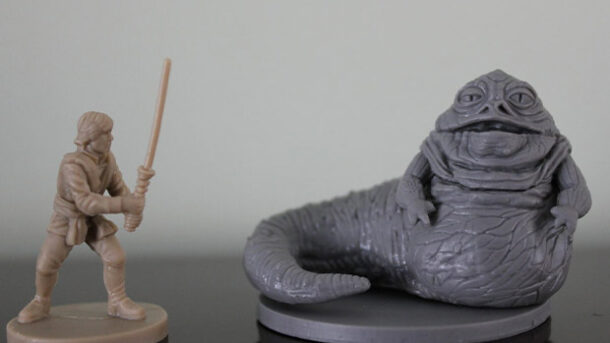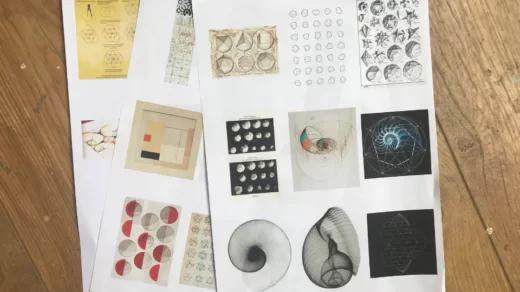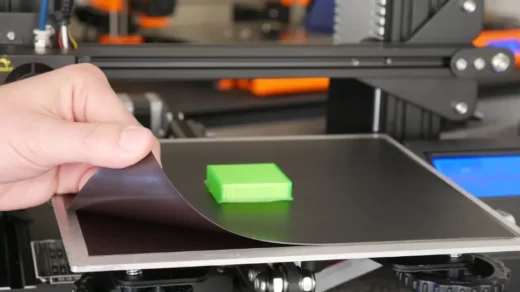Even though video games have largely replaced tabletop role-playing, many people still prefer to play games in person. Unfortunately, gaming miniatures can be quite expensive. For fans, printing their characters in 3D is a practical and possibly cost-effective alternative.
Finding the right model is a crucial issue, especially for those who are new to 3D printers. When choosing the best 3D printer for miniatures, there are a lot of options to choose from and everyone has a certain need to balance their own budget.
This article lists our top picks for the best 3D printer for miniatures and discusses the crucial features to take into account when making your choice. Keep reading!
Table of Contents
Best 3D Printer For Miniatures: Top Picks
- 1. Elegoo Mars 2 Pro Mono
- 2. Anycubic Mono X 6K
- 3. Anycubic Photon M3
- 4. Ender 5 Plus
- 5. Phrozen Sonic Mini 8K
- 6. Creality Ender 3 V2
- 7. Anycubic Photon Mono 4K Resin 3D Printer
- 8. Phrozen Sonic Mini 4K LCD Resin 3D Printer
Best 3D Printers For Miniatures & Reviews
1. Elegoo Mars 2 Pro Mono
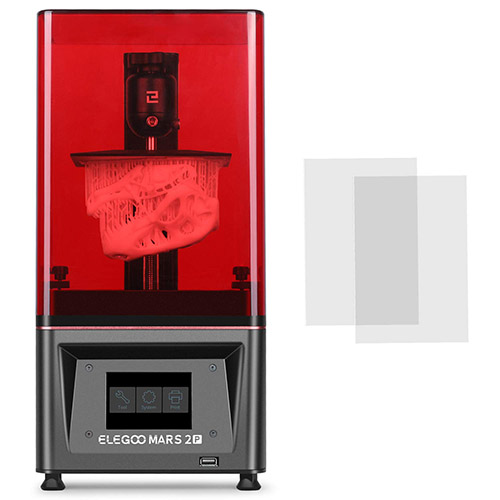
Elegoo Mars 2 Pro, the best low-cost resin 3D printer for miniatures, has quickly established itself as a standard in desktop 3D printing thanks to its ability to print at rapid speeds and in incredibly fine detail.
The Elegoo Mars could be the ideal 3D printer for miniatures and tabletop models for makers who are familiar with 3D printing and at ease with the additional challenges of resin printing. Compared to FDM printers, it can print models that are smoother with clearer, crisper finishes, and the resins it uses are less expensive now.
The printer’s layer resolutions range from 0.01-0.2mm thanks to the 2K 6&Prime LCD screen, which also provides excellent precision for solidifying resins. If you don’t mind slightly less durable parts, it also includes helpful features like tools that hollow out models before you print them to reduce material costs, along with the highly regarded resin 3D slicer CHITUBOX, which slices models quickly to save you time.
Overall, the Elegoo Mars 2 Pro Mono is one of the best low-cost resin printers available, and if you have the technical know-how, you might find that resin printing best suits your needs for producing miniatures.
PROS
- Top value: The Mars 2 Pro is your best choice if you’re content with a 2K LCD. Choose the Elegoo Mars 3 or Photon M3 if you can afford it.
- The miniatures we printed with it had amazing detail, which really impressed us.
CONS
- Newer, higher-spec printers have since been released – however, most cost more
2. Anycubic Mono X 6K
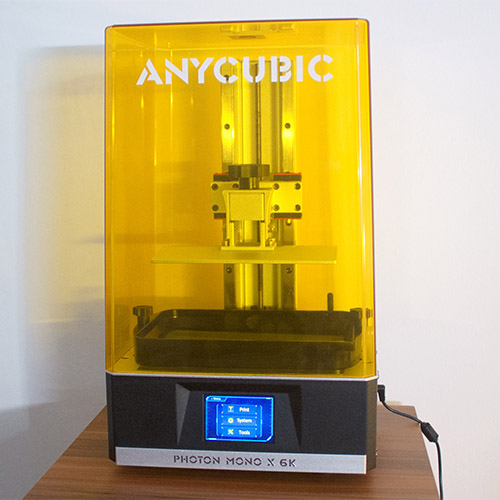
The Anycubic Mono X 6K, which is positioned as an upgrade to the well-liked entry-level Mono X, builds on the popular Mono X’s strong foundations and superb construction rather than inventing new ground.
A move to a 6K display, an improved light matrix to increase curing uniformity, and a larger 9.25″ LCD are in front of this. This translates into high print quality and a sharper 34-micron XY resolution over a larger surface area.
For modelers of miniatures, this translates into a noticeable improvement in quality over the Mono X, especially for smaller details like hair, scales, horns, armor detail, and facial features.
Due to the Anycubic Mono X 6K’s spacious 197 x 122 x 250 mm build volume for a resin printer, this is true for both large and small figures or models. To put it another way, the Anycubic Mono X 6K is just as well suited to printing massive Warhammer tanks, knights, and war hounds as it is to printing traditional 28 mm space marine miniatures.
When it was the highest-quality mid-range resin printer available, we highly recommended the Mono X, and the Mono X 6K excels in building on this. If you’re happy with a 4K resolution, the Photon M3 is a great choice if you want to save money because the Mono X 6K is twice as expensive.
The Photon M3 still represents the most affordable option for casual Warhammer players and those who enjoy the occasional Friday night D&D session. But the Mono X 6K is the best option available for next-generation resolution.
PROS
- The Mono X was already a top choice; now it has been improved.
- 6K Extensive details are rendered beautifully on LCD.
- larger build volume for producing many miniatures at once.
CONS
- costly in comparison to inexpensive 3D printers for miniatures.
- Choose a Photon M3, Photon Mono 4K, or Elegoo Mars 3 if you don’t require full 6K quality.
3. Anycubic Photon M3
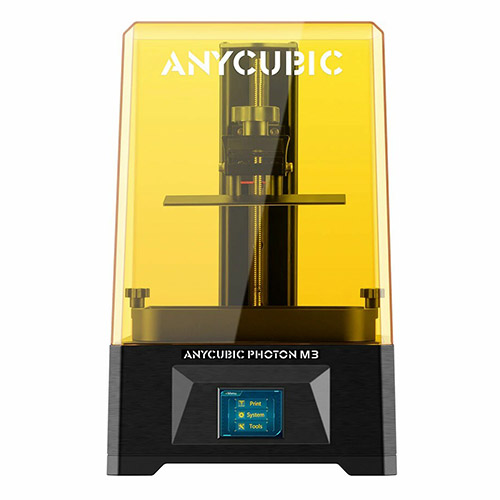
By including better specifications at the same price as its predecessors, the Photon Mono and Mono 4K, the recently released Anycubic Photon M3 finds its footing in the miniature manufacturing industry.
Larger build volumes of 163 x 103 x 180 mm highlight these improvements the most. On paper, this may not seem like much, but it means that the Anycubic Photon M3 can batch print more copies of the same model in a single sitting than the Mono 4K, let alone the original Mono, and produce single models that are much larger.
The additional z-height makes taller models easier to create, which is great if you’re trying to make big figurines for displays.
The Anycubic Photon M3 and Mono 4K both use a monochrome 4K LCD, but the Photon M3’s larger 7.6″ screen handles the larger build volume. As a result, the Mono 4 K’s 35-micron XY resolution has been downgraded to a 40 micron resolution. However, at these low resolutions, even seasoned miniature enthusiasts cannot tell the difference with the naked eye.
Due to the larger build volume, we still advise purchasing the Photon M3 over the Mono 4K because, even in the most accurate miniatures, a 5-micron difference will not be noticeable at this level.
There is no competition for the Anycubic Photon M3’s superior fine details and features on even the most intricate Warhammer and D&D figures when compared to the standard Mono’s 2K LCD. It does so quickly as well, with a respectable print speed of 50 mm/h, or roughly 30 minutes for a 28 mm model.
PROS
- Extremely affordable.
- Perfect for larger miniatures, especially taller models.
CONS
- Compared to the Mono 4K, the Photon M3 has a slightly lower resolution, but this is only because of the Photon M3’s larger screen and build volume.
4. Ender 5 Plus
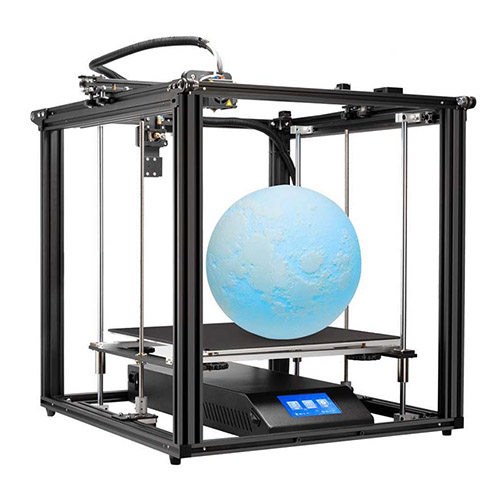
The Ender 5 Plus is a great alternative if you’re considering a cheap FDM printer like the well-liked Ender 3, but its build volume isn’t quite sufficient for the size of the terrain you’re planning to print.
It enlarges the build volume to a generous 350 x 350 x 400 mm, which is perfect for those expansive backdrops for your tabletop and D&D adventures that just won’t fit on an Ender 3.
This volume size should satisfy all of your terrain printing needs as far as low-cost consumer-grade printers go. It works especially well for elaborate ruins, battlegrounds, towers, rocky outcrops, dungeons, and other settings of the sort; it’s ideal for enhancing that crucial sense of immersion.
In addition to the large format, the Ender 5 Plus has a few useful advantages over the Ender 3. It includes a BLTouch automatic bed leveling probe to save you time and effort so you can focus on creating realistic terrain.
Additionally, dual z-axis lead screws are present to enhance stability and consequently, print quality overall. It also has a filament sensor, which notifies you if the filament runs out or breaks, so you don’t waste time on prints that won’t finish.
Although the Ender 5 Plus costs more than twice as much as the Ender 3, if you can stretch your budget, it’s a versatile terrain printer that’s well worth the extra cash. It is the best 3D printer for miniatures terrain.
PROS
- 350 x 350 x 400 mm build volume is enormous.
- Convenience features like a filament sensor and automatic bed leveling.
- Large backdrops and terrain models are ideal for this.
CONS
- Priced more than twice as much as the Ender 3 and Ender 3 V2.
5. Phrozen Sonic Mini 8K
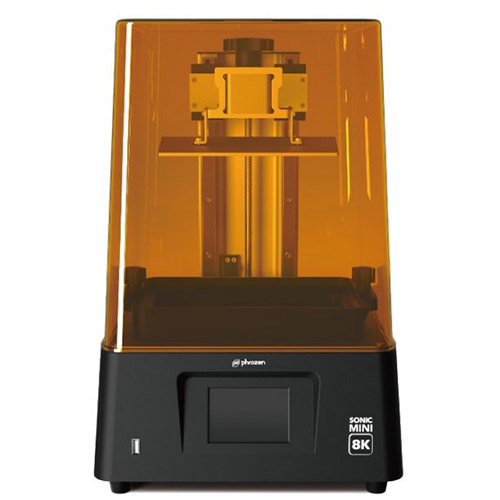
The Phrozen Sonic Mini 8K is widely regarded as one of the best consumer-grade resin 3D printers available and is perfect for producing incredibly high-quality miniatures, whether for tabletop gaming, display, or war gaming.
Unless you go completely industrial, the Phrozen Sonic Mini 8K is as high-end as the best 3D printers for miniatures get, if you can stomach the price tag.
Best-in-class 22-micron XY resolution is provided by the Phrozen Sonic Mini 8K. It outperforms well-liked resin printers like the Elegoo Mars family and the Anycubic Photon Mono X 6K and Mono 4K. Even on tiny 28 mm miniatures, this level of resolution allows for the exquisite rendering of even the smallest features in use.
Even though it can produce excellent miniatures, the Phrozen Sonic Mini 8K does have one significant disadvantage when compared to other resin printers: a relatively small build volume.
With dimensions of 165 x 72 x 180 mm, it is comparable to much less expensive options like the Anycubic Photon Mono 4K.
The Anycubic Mono X 6K, Elegoo Saturn S, or the Sonic Mighty range from Phrozen are all good options if you need to print large quantities of one large figure at a time for your business or home games. However, they do limit your options for batch printing multiple at once.
The Phrozen Sonic Mini 8K is largely unmatched if you’re looking for the highest quality miniatures and aren’t too concerned about a slightly smaller build volume.
PROS
- 22 micron XY resolution that is best in class.
- ideal for 28 mm scale miniature figures with fine details and features.
CONS
- For the price, a reasonably small build volume.
6. Creality Ender 3 V2
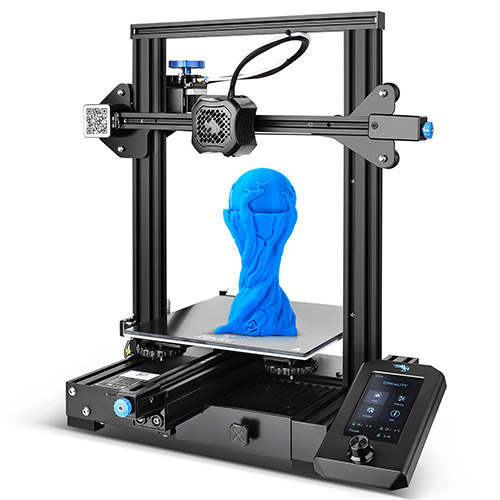
The Ender 3 is regarded as one of the best affordable 3D printers available and is renowned for its dependability and efficiency for the cost. Although it is packaged as a 3D printer kit, putting it together only takes a short while and requires 20 screws.
Due to the fact that it is an FDM printer, it cannot print with the same level of precision as an Elegoo or Anycubic resin printer. Due to its affordability, dependability, and respectable print volume of 220 x 220 x 250 mm, it is one of the best FDM 3D printers for terrain for miniatures.
You can use it to print miniatures if you want to avoid resin printing, but they won’t have the same level of precision and you’ll need to do some sanding and general post-processing to get them closer to the level you’re happy with.
However, the Ender 3 V2 is the best printer for terrain in its price range, and PLA filament is incredibly inexpensive and simple to use. Only if you want to print large towers or terrain that doesn’t fit within the build volume could you run into problems.
PROS
- Best low-cost FDM kit; simple to construct and print with, dependable, and long-lasting.
- Very upgradeable: available upgrades for the hotel, bed, and extruders.
CONS
- Not well suited to miniatures; stick to terrain and strongly consider a resin printer in their place.
7. Anycubic Photon Mono 4K Resin 3D Printer
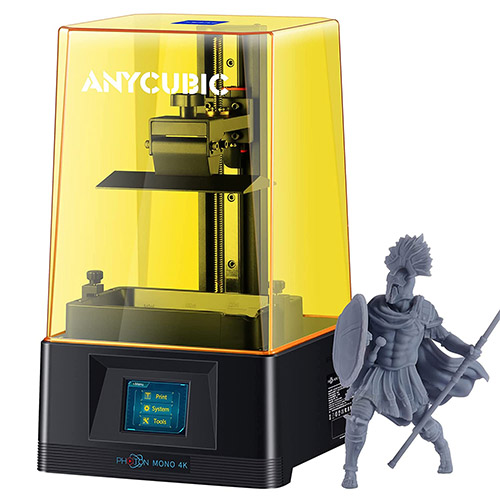
With new performance levels coming from a cost-effective 3D resin printer, the original Anycubic Photon Mono created quite a stir when it was released. There is no better printer for the money when printing 3D miniatures because the higher resolution 4K version now offers even more detail.
The 6.23-inch monochrome screen has a resolution of 3840 x 2400 pixels, or 727 PPI. 35 microns is the horizontal precision. Class-leading detail is the result when you combine that with a layer height of only 10 microns. The sharp edges and corners are a result of the high contrast ratio (the distinction between exposed and unexposed pixels). With a top speed of 50mm (2 inches) per hour, this device is also quite quick. The only thing needed to start using the machine is leveling. The free Photon Workshop software offers all the necessary control, and the touchscreen panel is simple to use.
PROS
- Highly detailed miniature
- Minimal setup
- Relatively easy to use
CONS
- Not the best for beginners
- Poor customer support
8. Phrozen Sonic Mini 4K LCD Resin 3D Printer
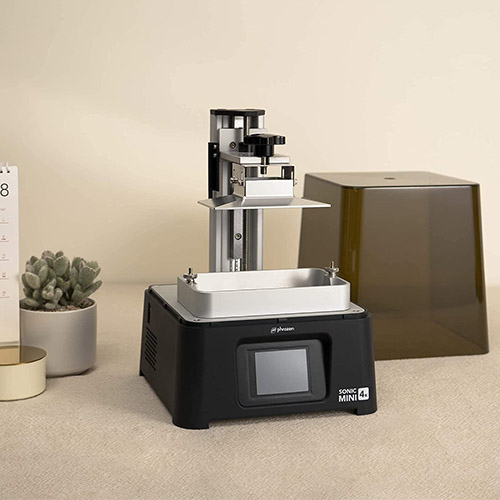
A strong contender for the title of the best 3D printer for miniatures is the Phrozen Sonic Mini 4K, which directly competes with the Anycubic Photon 4K. In independent reviews, they frequently place first and second. The Phrozen Sonic Mini 4K clearly outperforms the Anycubic model in terms of speed, but the Anycubic model earns our top spot for its combination of quality and value.
Its screen measures 6.1 inches and has a 4K resolution of 3840 x 2160 pixels with a pixel density of 722. Layer height and horizontal pixel size are both 35 microns. Technically speaking, the Phrozen and the Anycubic have almost identical print specifications, and the detail for 3D miniature printing is excellent. However, the Phrozen can operate at an impressive 80mm (3.15 inches) per hour, which is about a 30% improvement over its closest competitor.
PROS
- Highly detailed miniatures
- Very fast printing
- Competitive pricing
CONS
- Modest build volume
- Not particularly quiet
Why 3D Print Your Own Miniatures?
With a 3D printer, you can print anything you want while also making up to 90% more savings on the purchase price than you would if you were restricted to the models shown in the miniatures companies’ catalogs and required to pay more than $10 per model.
Even premium models are incredibly affordable, frequently costing only a few dollars, thanks to some designers who publish their miniature files for free online (we list the best sites later). You also get to keep the STL file after purchasing these, allowing you to print the model repeatedly.
Some premium files even come with their slicer profiles already created, requiring only import and printing.
Therefore, choice and cost are the two main considerations when deciding whether to buy or 3D print your tabletop miniatures.
Also Read: Best 3D Printer under $500
Factors To Consider For Best 3D Printers For Miniatures
The creation of 3D-printed figures can be done with a wide range of machines, but purchasing a larger machine than is necessary is not really necessary. The machines we selected, as a result, are all reasonably affordable and compact. Here are the other factors we considered when making our selections:
Precision: In general, fine detail creation skills are more crucial than build volume (model size). However, the versatility allows for the construction of other types of models as well, allowing you to get the most out of your purchase. While printing 3D miniatures was our main focus, the machines we chose can also produce other models.
Ease of Use: Miniature 3D printers fall into one of two categories, resin or filament, similar to all 3D printers. Resin allows for greater detail but is unpleasant to work with and can be challenging. While filament produces a lower level of detail, it is perfect for beginners. While resin printers dominate our list, we have a filament model to show the advantages.
Brand and Price: Finding very affordable machines that can create 3D-printed miniatures is not difficult. Nevertheless, outcomes occasionally disappoint. While we have made every effort to keep costs as low as possible, we have limited our selections to companies with a reputation for excellence and dependability.
Print area: The larger build areas of MSLA printers allow you to print more models in the same amount of time while simultaneously curing entire resin layers.
Stable, metal frame: a heavy frame is less influenced by other variables such as the vibrations that can affect model quality, even slightly. Accurate miniatures require high-quality components, so choose a printer from a well-known company with a reputation for producing durable goods.
Final Verdict
Choosing just one best 3D printer for miniatures is difficult, and each of our choices has some advantages. Due to its exceptional value and performance, the Anycubic Photon Mono 4K wins the top prize. There are machines that are faster and there are machines that can produce more detail, but each is more expensive, and for many miniaturists, the benefits might not be worth the added expense.
The Elegoo Mars 2 Pro also has a lot to recommend, and we especially like the carbon air filter because it makes it much more comfortable to live with. The quality is excellent given the lower price, but it cannot match the Anycubic in terms of detail.
More To Explore:
FAQs
How Long Does It Take To Print Miniature Models?
It is nearly impossible to estimate how long it takes to print miniature models because of factors like size, complexity, and printer settings. Small ones will almost certainly take at least an hour, but complicated models could take ten hours or longer.
Can I Print Miniatures Using 3D Technology And Sell Them?
Miniatures of your own original designs are 3D printable and marketable. You cannot copy figures that are copyrighted (like “Warhammer” figures, “Dungeons & Dragons”, etc.). Normally, downloading files from the internet is also prohibited from being printed and sold. They are typically labeled for non-commercial use. Even if you pay for one of these files—which is often the case—you still do not have the right to make money off of it. It is crucial to review the license agreement because failing to do so could result in legal action.
Is A Resin Printer Necessary For Miniatures?
It largely comes down to priorities. While resin 3D printers produce higher detail and smoother results, filament (FDM) 3D printers are more user-friendly and can produce models of good quality. A resin printer is unquestionably the better option if the latter is crucial.
Is It Legal To Make Warhammer Figure 3D Printing?
It is legal to 3D print “Warhammer” figures, or any other figure that is copyrighted, as long as they are for personal use playing with friends or family, for example. They cannot be purchased legally and cannot be used during competitions.

